Look for the planet Saturn in the vicinity of the moon as darkness falls on September 7 and 8, 2019. Saturn is actually a bit brighter than a 1st-magnitude star, but this world still might be hard to see in the moon’s glare. If so, try placing your finger over the obtrusive waxing gibbous moon for a better view of Saturn, the most distant world that you can easily see with the eye alone.
For all the world, the moon is seen in between Saturn and the king planet Jupiter on September 7. Below, we show you a more expanded view of the sky that includes both Saturn and Jupiter. Although the chart is especially made for mid-northern North American latitudes, you can still find Saturn rather easily from anywhere worldwide. Look first for Jupiter – by far the brightest “star” in the evening sky, and that “star” on the other side of the moon on September 7 will be Saturn.

From North America, we see the moon to the west of Saturn as darkness falls on September 7, and then to the east of the moon as darkness falls on September 8. Keep in mind that the moon appears much larger on our charts than in the real sky. From nightfall September 7 until nightfall September 8, the moon’s change of position amounts to about 12 degrees (24 moon-diameters).
At nightfall on September 7, from the world’s Eastern Hemisphere, the moon will appear farther west of Saturn, and more offset in the direction of Jupiter, than it’ll be at nightfall September 7 in North America. Here, in North America, the moon is more or less equally distant from the moon on September 7 and 8; from the Eastern Hemisphere, the moon will be closer to Saturn on September 8 than on September 7.
At nightfall on September 8, most of the world’s Eastern Hemisphere (Europe, Africa, western Asia) will see the moon to the east of Saturn (as we do in North America). From the far-eastern regions of the Eastern Hemisphere (eastern Asia, Indonesia, Australia and New Zealand), as darkness falls on September 8, the moon will actually appear to the west (not to the east) of Saturn.

Best of all, if you live in just the right spots in Australia and Indonesia, you can watch the moon occult (cover over) Saturn in a nighttime sky as the moon moves from the west of Saturn to the east of Saturn on the night of September 8-9. 2019. Saturn will disappear behind the moon’s dark side and then reappear from behind the moon’s illuminated side.
We are at the tail end of a monthly series of 14 Saturn occultations that started on December 9, 2018, and will end on November 29, 2019. However, you have to be at just the right spot on Earth to witness any one of these occultations. The next series will present 12 Saturn occultations from April 6, 2024 until February 1, 2025.
These next couple of nights – September 7 and 8, 2019 – use the waxing gibbous moon to find the planet Saturn.











